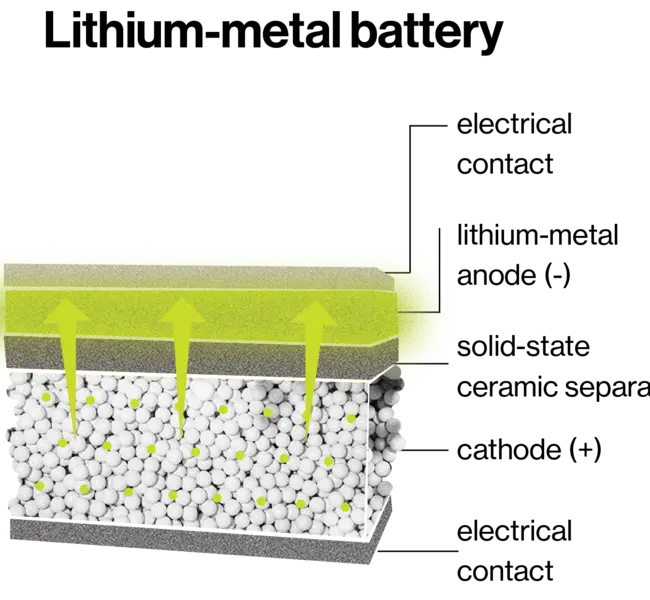Regarding batteries, two prominent types often come into the spotlight: lithium-metal and lithium-ion batteries. These two battery technologies have their unique characteristics and applications. This article will explore the key differences between lithium-metal and lithium-ion batteries, highlighting their advantages and limitations.
Part 1. What is a lithium-metal battery?

A lithium-metal battery uses metallic lithium as its anode. It’s famous for holding lots of energy in a small, light package. These batteries are great for things needing lots of power in a small space, like electric cars and gadgets.
Lithium ions move between the cathode and anode in lithium-metal batteries when charging and discharging. The battery stores lithium ions as metallic lithium at the anode when charging. It releases stored energy when discharging as lithium ions move back to the cathode.
Part 2. Lithium-metal battery advantages
- Higher energy density: Lithium-metal batteries offer significantly higher energy density than traditional lithium-ion batteries, allowing electronic devices to enjoy longer-lasting power.
- Lightweight construction: The lightweight nature of lithium-metal batteries makes them well-suited for portable applications like smartphones, laptops, and electric vehicles, as they help reduce overall device weight.
- Faster charging capabilities: Lithium-metal batteries enable speedier charging, allowing quicker battery power replenishment within a shorter time frame.
- Enhanced performance in extreme temperatures: These batteries exhibit improved performance even in extreme temperatures, maintaining their efficiency and functionality in hot and cold conditions.
- Longer lifespan: Lithium-metal batteries have a longer lifespan than conventional batteries, resulting in fewer replacements and reduced environmental impact over time.
- Compatibility with emerging technologies: Lithium-metal batteries are compatible with emerging technologies such as electric vehicles and renewable energy storage systems. This compatibility drives innovation in sustainable energy solutions and contributes to the growth of these industries.
Part 3. Lithium-metal battery limitations
- Safety concerns: The potential for dendrite formation in lithium-metal batteries can lead to short circuits and thermal runaway, posing risks of fire and explosions. Ensuring safety measures and robust battery designs are crucial to mitigate these risks.
- Limited cycle life: Lithium-metal batteries have a shorter cycle life than lithium-ion batteries. Careful management of charging and discharging cycles is necessary to prolong battery longevity and maintain optimal performance.
- Sensitivity to overcharging and over-discharging: Lithium-metal batteries are sensitive to overcharging and over-discharging, leading to performance degradation and potential damage. Sophisticated battery management systems are required to prevent such occurrences and ensure safe and efficient operation.
- Higher production costs: The production of lithium-metal batteries is currently more expensive compared to traditional lithium-ion batteries. This higher cost can limit their widespread adoption, especially in cost-sensitive markets.
- Scaling up production challenges: Meeting the increasing demand for lithium-metal batteries poses challenges in scaling up production. Supply chain constraints and potential market shortages may occur as manufacturers work to expand their production capacities.
- Regulatory restrictions: Due to their flammability and potential environmental hazards, lithium-metal batteries are subject to regulatory limits on transportation and disposal. Compliance with these regulations adds complexity to the handling and managing of these batteries.
Part 4. What is a lithium-ion battery?

Lithium-ion batteries don’t use metallic lithium in their anode. They use a carbon material like graphite instead. These batteries have several parts, including the cathode, anode, separator, and electrolyte.
Lithium ions move from the cathode to the anode through the electrolyte during charging. The anode stores them in its structure. When the battery discharges, it releases lithium ions to the cathode, creating electrical energy for the device.
Lithium-ion batteries are great because they last a long time and have lots of power. They’re used in smartphones, laptops, power tools, and renewable energy systems because they’re reliable and efficient.
Part 5. Lithium-ion battery advantages
- High energy density: Lithium-ion batteries offer a high energy density, meaning they can store significant power per unit weight and volume. This feature allows electronic devices to have longer-lasting battery life.
- Lightweight and compact design: Lithium-ion batteries are known for their lightweight and compact design, making them ideal for a wide range of portable electronic devices such as smartphones, laptops, and wearable technology.
- Fast charging capability: Lithium-ion batteries can charge quickly, allowing users to replenish battery power in a shorter amount of time, enhancing convenience and usability.
- Long cycle life: These batteries can withstand many charge-discharge cycles before significant capacity degradation occurs. With proper care and management, lithium-ion batteries can last hundreds to thousands of cycles, providing long-term reliable performance.
- Low self-discharge rate: Lithium-ion batteries are low, meaning they can retain stored energy for extended periods even when unused. Devices powered by these batteries can maintain their charge when idle.
- Application versatility: Lithium-ion batteries find applications in various industries, including consumer electronics, automotive, and renewable energy storage. Their versatility and compatibility with different technologies contribute to their widespread adoption and integration into numerous devices and systems.
Part 6. Lithium-ion battery limitations
- Capacity degradation: Over time, lithium-ion batteries experience degradation due to cycling, resulting in reduced capacity and a shorter overall lifespan. This degradation requires regular monitoring and eventual replacement of the battery.
- Safety concerns: If a lithium-ion battery is damaged, overcharged, or exposed to high temperatures, it can undergo thermal runaway, a rapid and uncontrolled increase in temperature. These safety risks, such as fire or explosion, require proper handling, charging, and storage practices to mitigate.
- Limited energy storage capacity: Lithium-ion batteries offer high energy density, but their storage capacity still needs to be improved compared to alternative battery technologies. This limitation can constrain their use in applications requiring high energy demand or long operation durations.
- Sensitivity to high temperatures: Lithium-ion batteries are sensitive to high temperatures, which can accelerate degradation and increase the risk of thermal runaway. Maintaining proper temperature conditions during use and storage is crucial for optimal battery performance and safety.
- Higher production costs: The production of lithium-ion batteries can be more expensive compared to some older battery types. This higher cost of production may impact the affordability of devices or systems that rely on lithium-ion batteries, potentially affecting consumer adoption and market penetration.
Part 7. Difference between lithium-ion battery and lithium-metal battery
1. Chemical Composition:
- Lithium-ion batteries utilize lithium ions moving between the cathode and anode during charge and discharge cycles. The anode typically comprises graphite or other materials capable of intercalating lithium ions.
- Lithium-metal batteries, conversely, use metallic lithium as the anode. Lithium ions from the cathode deposit onto the lithium-metal anode during charging, and lithium ions return to the cathode during discharge.
2. Energy Density:
- Lithium-metal batteries generally boast higher energy densities compared to lithium-ion batteries. These batteries can store more energy per unit of volume or weight, resulting in longer-lasting power sources for various applications.
3. Safety Profile:
- Lithium-metal batteries tend to pose more significant safety risks due to the formation of dendrites, which are needle-like structures that can grow and potentially cause short circuits within the battery. The formation of dendrites can lead to thermal runaway, increasing the risk of fire or explosion.
- Lithium-ion batteries have more established safety features and are less prone to dendrite formation. However, they still require careful handling and management to prevent overheating or other safety hazards.
4. Cycle Life:
- Lithium-ion batteries generally exhibit longer cycle lives compared to lithium-metal batteries. The rapid degradation of lithium-metal batteries over time is due to the formation of dendrites and other factors. This degradation leads to reduced capacity and performance.
5. Charging Speed:
- Lithium-metal batteries may offer faster charging capabilities compared to lithium-ion batteries. This efficiency is partly due to the higher energy density and unique characteristics of metallic lithium, which facilitate more efficient charging and discharging processes.
6. Commercial Availability:
- Lithium-ion batteries have been extensively commercialized and are widely available across various industries and consumer electronics products.
- Lithium-metal batteries are still in development and have yet to reach the same level of commercial availability. Research and development efforts are ongoing to address safety concerns and scale up production for broader applications.
7. Cost:
- Lithium-ion batteries currently have a cost advantage over lithium-metal batteries. The main reason for this cost advantage is that lithium-ion battery technology is more mature, with established production processes and supply chains that help drive down costs.
- Lithium-metal batteries may be more expensive due to the challenges associated with manufacturing and ensuring safety. However, costs may decrease as technology advances and companies achieve economies of scale.
8. Environmental Impact:
- Both lithium-ion and lithium-metal batteries have environmental considerations. Lithium-ion batteries contain toxic materials such as cobalt, nickel, and lithium, posing environmental risks if not properly recycled.
- Lithium-metal batteries also have environmental concerns, particularly regarding the disposal of metallic lithium. Metallic lithium can react with moisture or other substances, potentially causing fires or releasing hazardous compounds.
Part 8. FAQs
-
Are lithium metal batteries better than lithium-ion?
Lithium metal batteries have higher energy densities, potentially offering longer-lasting power in a smaller size. However, they also pose safety concerns due to dendrite formation. -
How long do lithium metal batteries last?
Lithium metal batteries typically have a lifespan of around 5 to 10 years or approximately 300 to 500 charge-discharge cycles. However, this can vary based on usage patterns, charging protocols, and environmental conditions -
Which lithium battery lasts the longest?
Lithium-ion batteries often have longer lifespans compared to lithium-metal batteries. They can typically last for several years, with some high-quality lithium-ion batteries lasting up to 10 years or more under normal usage conditions. -
What battery is replacing lithium-ion?
There are several emerging battery technologies aiming to complement or replace lithium-ion batteries. Examples include solid-state batteries, lithium-sulfur batteries, and sodium-ion batteries. -
What metal can replace lithium?
Researchers are exploring various metals as potential alternatives to lithium in batteries, including sodium, magnesium, and aluminum. These metals offer different properties and may address certain limitations associated with lithium batteries, such as cost and resource availability.
Related Tags:
More Articles

Overview of Deep Cycle Lithium Battery
In this article, we explore the life, voltage, capacity, and charging considerations of deep cycle lithium batteries.
How Long do Lithium Batteries Last?
How long do lithium batteries last? we will explore the factors that influence the lifespan of lithium batteries and provide insights into their longevity.
How to Choose the Best LiFePO4 Battery?
Choose LiFePO4 batteries for superior performance, safety, and versatility in EVs, UPS, and backup power. This guide helps you make informed decisions.
Get 12v Lithium Car Battery As a Power Source for the Ride
Make the right choice for your vehicle's battery needs by installing a 12 volt lithium car battery. You will enjoy maintenance-free longevity with this change.
Everything About A Small Lithium Ion Battery
Discover the features, uses & future potential of a small lithium ion battery. A compact and tiny powerhouse ideal for smartphones, wearables, drones & more.





